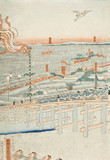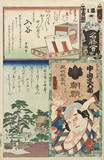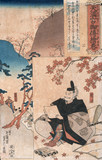The Lavenburg Collection of Japanese Prints. http://www.myjapanesehanga.com/home/artists/utagawa-sadahide-1807-1873. Sadahide 貞秀 (1807-1873)1; school: Utagawa 歌川; other names: Gyokuransai 玉蘭斎, Gountei 五雲亭, Gyokuō 玉翁 Disciple of Kunisada I (Toyokuni III)
Source: The World of the Meiji Print: Impressions of a New Civilization, Julia Meech-Pekarik, Weatherhill, 1986, p. 40.
Sadahide was born as Hashimoto Kenjiro in Shimosa Province (modern Chiba Prefecture) near Edo. He became a student of Utagawa Kunisada I (1786–1865), also known as Tokokuni III (hence the sada character in his own professional name) and usually signed himself Gountei Sadahide. He is also known as Hashimoto and Gyokuransai Sadahide.
His early work, beginning in 1826, was mainly book illustrations, but in the 1830s he began to produce color prints of conventional subjects such as beautiful women and actors.
Sadahide is best known for his yokohama-e (prints from the Western enclave of Yokohama depicting scenes with Westerners.) Long before the opening of the port at Yokohama in 1859, he was keenly interested in foreign affairs. He has been credited with compiling the drawings for Kaigai shinwa (Overseas news), a book published around 1850 about the Opium Wars (1839-1842) in China, an opportunity for him to portray English soldiers and battleships. The emphasis throughout is on British military power and brutality. In 1855 he illustrated Kita Ezo zusetsu (Illustrated notes on norther Ezo), written by Mamiya Tomonmune, one of the first explorers of Japan's lonely northern island of Hokkaido. Already Sadahide had identified himself as a man working outside the mainstream, preferring to focus on the border zones, restlessly pushing at the frontiers of the tiny island nation. In the 1850s he gained a reputation for cartography and produced a world map, surprisingly accurate and probably modeled after a Dutch original. His first Yokohama prints in 1859-1860 were panoramic maps of this sort, but he soon began to specialize in pictures of foreigners, designing fifty-five prints in 1860, forty in 1861, three in 1862, and finally none at all in 1863, by which time publishers and public alike were fully satiated with hairy barbarians and had turned their attention to more critical domestic matters.
Sadahide then moved on to Nagasake, where he continued to create panoramas, including one that was an astounding thirty-three feet long. In 1868 he was listed among the most famous artists of the capital2, perhaps in recognition of the government's selection of ten of his prints (views of Edo) for exhibition in the Paris International Exposition in 1866. In 1871, at the age of sixty-four, he made a final gigantic Yokohama print, the size of a tatami mat (six feet by three feet); in this late period he also illustrated a number of educational woodblock-printed books dealing with the history and geography of the Western world.
Critical Praise
Sadahide is considered one of Utagawa Kunisada's more accomplished students.3 He was a fine draftsman and often managed to bring a flair for compositional design to his pictures, when many of his contemporaries relied solely on pictorial reporting.4 He is also one of the finest artists in whose work Western stylistic elements are incorporated in a completely convincing manner. His deft use of Western perspective is combined with such typical ukiyo-e elements as the abrupt cutting off of the representation by the border of the picture plane, and shading to indicate modeling of the figures is juxtaposed with flat planes. Sadahide's work certainly influenced the later artists of the Utagawa school, who specialized in prints reporting actual events of the Meiji period, but most of these artists lacked his power of expression and depicted the much-changed Meiji world in the manner of their Tokugawa forebears.5
Sadahide did not paint pictures of only Yokohama, but painted bird's-eye view paintings of other cities, including Osaka, Kyoto, and Nagasaki, and is a leading exponent of the Ichiranzu (Panoramic View), as bird's-eye view paintings were called at that time. These bird's-eye view paintings of cities, painted from the latter part of the Edo period through the early part of the Meiji period, freely distort space and exaggerate specific objects while adopting the perspective drawing method of painting. As such, they are excellent resources for providing clues as to the images that the people of the day had of their cities and which area of these cities attracted their interest.
1 There is some question about the correct date of the artist's death, with 1873 (Richard Illing, The Art of Japanese Prints), 1878 and 1879 being given.
2 According to the 1865 Hayari Ichiransai Seiki, the ranking of the most popular ukiyo-e artists in 1865 was as follows: Kiyomitsu, Sadahide, Yoshitora, Yoshitsuya, Kunisada, (2nd gen.) Hiroshige, Yoshiiku, Kunichika, Yoshifuji, Yoshitoshi, and Kuniteru. (Source: Kyoto University of Art and Design - Database on Yakusha-e Prints from the end of Edo to beginning of Meiji Era http://kensaku.kyoto-art.ac.jp/ukiyoe/kuni_e.html)
3 Lawrence University website http://www.lawrence.edu/dept/wriston/collections/jwp/utagawa%20sadahide.htm
4 The Art of Japanese Prints, Richard Illing, John Calmann & Cooper Ltd., 1980, p. 156.
5 Ukiyo-e to Shin hanga - The Art of Japanese Woodblock Prints, Amy Newland and Chris Uhlenbeck, Brompton Books Corporation, 1990, p. 186.
Sadahide Utagawa
12 records
Include records without images
About this artist





